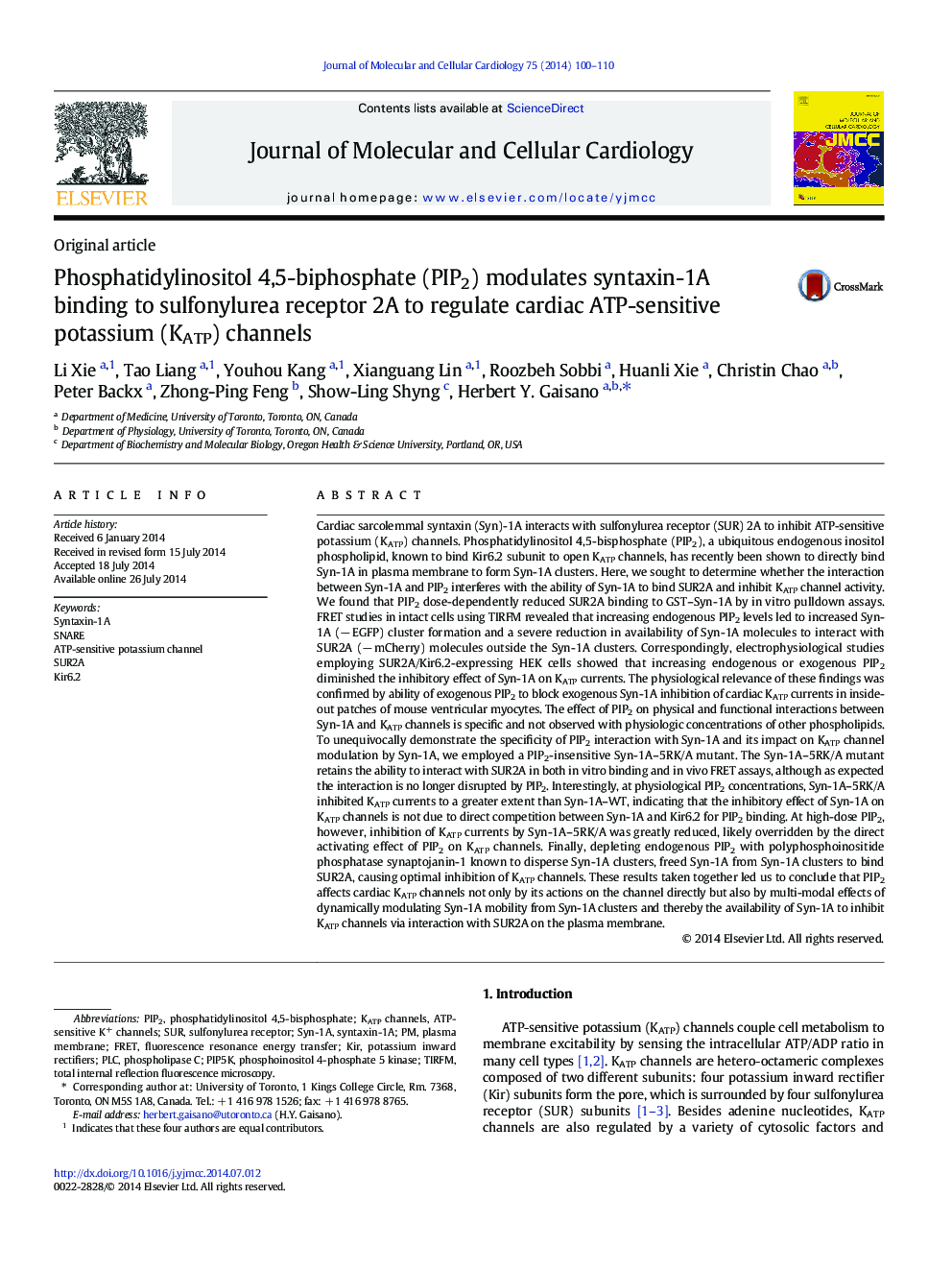| کد مقاله | کد نشریه | سال انتشار | مقاله انگلیسی | نسخه تمام متن |
|---|---|---|---|---|
| 8474669 | 1550430 | 2014 | 11 صفحه PDF | دانلود رایگان |
عنوان انگلیسی مقاله ISI
Phosphatidylinositol 4,5-biphosphate (PIP2) modulates syntaxin-1A binding to sulfonylurea receptor 2A to regulate cardiac ATP-sensitive potassium (KATP) channels
دانلود مقاله + سفارش ترجمه
دانلود مقاله ISI انگلیسی
رایگان برای ایرانیان
کلمات کلیدی
PLCPIP5KSNAREKirTIRFMSUR2APIP2Kir6.2Fluorescence resonance energy transfer - انتقال انرژی رزونانس FluorescenceFRET - انتقال انرژی رزونانسی فورسترsur - برPlasma membrane - غشای پلاسماphosphatidylinositol 4,5-bisphosphate - فسفاتیدیلینوزیتول 4،5-بیسفسفاتphospholipase C - فسفولیپاز CTotal internal reflection fluorescence microscopy - میکروسکوپ فلورسانس بازتاب داخلیATP-sensitive K+ channels - کانال های K + حساس به ATPKATP channels - کانال های KATPATP-sensitive potassium channel - کانال پتاسیم حساس به ATPsulfonylurea receptor - گیرنده سولفونیل اوره
موضوعات مرتبط
علوم زیستی و بیوفناوری
بیوشیمی، ژنتیک و زیست شناسی مولکولی
بیولوژی سلول
پیش نمایش صفحه اول مقاله

چکیده انگلیسی
Cardiac sarcolemmal syntaxin (Syn)-1A interacts with sulfonylurea receptor (SUR) 2A to inhibit ATP-sensitive potassium (KATP) channels. Phosphatidylinositol 4,5-bisphosphate (PIP2), a ubiquitous endogenous inositol phospholipid, known to bind Kir6.2 subunit to open KATP channels, has recently been shown to directly bind Syn-1A in plasma membrane to form Syn-1A clusters. Here, we sought to determine whether the interaction between Syn-1A and PIP2 interferes with the ability of Syn-1A to bind SUR2A and inhibit KATP channel activity. We found that PIP2 dose-dependently reduced SUR2A binding to GST-Syn-1A by in vitro pulldown assays. FRET studies in intact cells using TIRFM revealed that increasing endogenous PIP2 levels led to increased Syn-1A (â EGFP) cluster formation and a severe reduction in availability of Syn-1A molecules to interact with SUR2A (â mCherry) molecules outside the Syn-1A clusters. Correspondingly, electrophysiological studies employing SUR2A/Kir6.2-expressing HEK cells showed that increasing endogenous or exogenous PIP2 diminished the inhibitory effect of Syn-1A on KATP currents. The physiological relevance of these findings was confirmed by ability of exogenous PIP2 to block exogenous Syn-1A inhibition of cardiac KATP currents in inside-out patches of mouse ventricular myocytes. The effect of PIP2 on physical and functional interactions between Syn-1A and KATP channels is specific and not observed with physiologic concentrations of other phospholipids. To unequivocally demonstrate the specificity of PIP2 interaction with Syn-1A and its impact on KATP channel modulation by Syn-1A, we employed a PIP2-insensitive Syn-1A-5RK/A mutant. The Syn-1A-5RK/A mutant retains the ability to interact with SUR2A in both in vitro binding and in vivo FRET assays, although as expected the interaction is no longer disrupted by PIP2. Interestingly, at physiological PIP2 concentrations, Syn-1A-5RK/A inhibited KATP currents to a greater extent than Syn-1A-WT, indicating that the inhibitory effect of Syn-1A on KATP channels is not due to direct competition between Syn-1A and Kir6.2 for PIP2 binding. At high-dose PIP2, however, inhibition of KATP currents by Syn-1A-5RK/A was greatly reduced, likely overridden by the direct activating effect of PIP2 on KATP channels. Finally, depleting endogenous PIP2 with polyphosphoinositide phosphatase synaptojanin-1 known to disperse Syn-1A clusters, freed Syn-1A from Syn-1A clusters to bind SUR2A, causing optimal inhibition of KATP channels. These results taken together led us to conclude that PIP2 affects cardiac KATP channels not only by its actions on the channel directly but also by multi-modal effects of dynamically modulating Syn-1A mobility from Syn-1A clusters and thereby the availability of Syn-1A to inhibit KATP channels via interaction with SUR2A on the plasma membrane.
ناشر
Database: Elsevier - ScienceDirect (ساینس دایرکت)
Journal: Journal of Molecular and Cellular Cardiology - Volume 75, October 2014, Pages 100-110
Journal: Journal of Molecular and Cellular Cardiology - Volume 75, October 2014, Pages 100-110
نویسندگان
Li Xie, Tao Liang, Youhou Kang, Xianguang Lin, Roozbeh Sobbi, Huanli Xie, Christin Chao, Peter Backx, Zhong-Ping Feng, Show-Ling Shyng, Herbert Y. Gaisano,